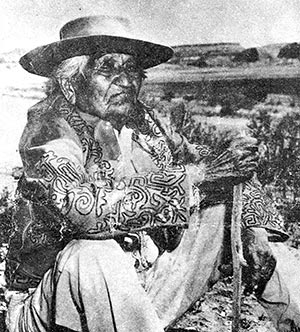Diné scout lies buried at Arlington
By Bill Donovan
Special to the Times
WINDOW ROCK, Jan. 22, 2009

(Courtesy photo)
The late Jeff King, who served as a U.S. Army scout in the late 1800s, is believe to be the only Diné to be laid to rest in Arlington National Cemetery. This photo was provided by his family and was published in the Navajo Times in 1964.
A mong the dozens of Navajo men and women honored on the walls of the Ellis Tanner Trading Co. is Jeff King, one of the most respected medicine men on the Navajo Reservation in the first half of the 20th century.
King, whose Navajo name was Haska-zilth-e-yah, served the U.S. Army as a scout and was buried in Arlington Cemetery when he died in 1964.
He is believed to be the only Navajo buried in the famed cemetery, where he keeps company with some of the nation's most famous leaders as well as thousands of his fellow soldiers.
King's official obituary lists his age at death as 99, but his descendants say he was 112 or 113 according to family records. And, they add, his legacy lives on in the Crownpoint area.
"Many of the elders in that area still remember him," said King's granddaughter Margie Boyd, who lives in Church Rock, N.M.
He is also remembered as a book author, although he never learned to write or speak English, and for his efforts to preserve one of the oldest of Navajo ceremonies.
The ceremony, Where the Two Came to Their Father, dates back several hundred years, according to historians. It was performed by medicine men to prepare those going to war and those who would be left behind in time of war.
It was later adapted to become part of the ceremonies to cure sickness but by the 1930s it was largely forgotten except in the mind of King, who had a lifelong fascination that began when he was about 10 and saw some drawings in a cave near his home in Crownpoint.
The drawings depicted a nine-day, nine-night ceremony. During the 1800s it was an important Navajo ceremony, according to federal officials who first became aware of it in 1885.
James Stevenson, a researcher for the U.S. Bureau of Ethnology, arrived on the reservation as the Navajos were about to begin the ceremony to benefit a tribal member whose vision was failing due to an eye inflammation.
Stevenson, one of about 1,200 people who were there to observe it, wrote a report about the experience in which he described the power and beauty of the ceremony.
A later report said, "It is conducted to protect warriors from danger - as during confrontations with Colonel Kit Carson's troops during the Fort Sumner years of 1863-68, and later during the Vietnam war - and others from hunger, accident, and sickness of either the body or mind."
While King's elders remembered the ceremony, there was no medicine man who was actually performing it anymore so King, who also performed the Hózhóójí (Blessing Way) and 'Anaa'jí (Enemy Way) ceremonies, spent most of his life researching the ceremony.
By World War II, he was able to perform the ceremony for many of the Navajos who were heading off to war.
In 1941 he met Maude Oakes, a non-Navajo artist who was spending two years on the Navajo Reservation. They became close friends and King grew to trust her enough that he shared what he knew of the Where the Two Came to Their Fathers ceremony and allowed her to publish it in a book.
"Where the Two Came to Their Father: A Navajo War Ceremonial Given by Jeff King" was first published in 1943 by the Princeton University Press. It has been out of print for 10 years but can still be found in antiquarian bookstores or through companies like Amazon.com, where it was listed this week at prices varying from $10 to $750.
Boyd said her grandfather also authored another book called "The Enemyway" with another writer but this appears to be even harder to find since there were no references to it at any of the usual sources.
King was the last surviving Navajo scout and according to local historian Martin Link, he is the only one to be buried at Arlington.
"As far as I know, he may also be the only Navajo buried there," Link said.
Not much is known about King's military service with the U.S. cavalry, during which Navajo scouts were mostly used to track down the few Apache groups that remained at large.
"He never talked about his days as a scout," said Boyd, adding that her grandfather did not feel that it was a good time for the reservation.
Census records for the Navajo Tribe, according to an obituary printed in the Navajo Times on Jan. 10, 1964, show that King enlisted as an Indian scout on July 23, 1891, at Fort Wingate, N.M.
He re-enlisted in 1901, 1904 and 1908 and then received an honorable discharge on Nov. 10, 1911. By that time he was a sergeant.
The obituary says he was born in Rock Springs, N.M., in 1865, and lived most of his adult years in Pinedale, N.M., existing on a small Army pension and what he made as a medicine man.
The Times article also mentioned that when the Fort Wingate Army Depot celebrated its centennial in 1960, King served as grand marshal of the celebration and later was part of a delegation that went to Washington, D.C., and met with high-ranking Army leaders.
Boyd said three of King's grandchildren still live in Pinedale - Johnny Largo, Roy Holtsoi and Marie Curley - while another grandchild, Marquita Clark, lives in Church Rock.

